
Rodrigo de Bastidas
Rodrigo de Bastidas (1445-1527) was a visionary and Spanish conqueror, founder of the city of Santa Marta, Colombia. He conquered the Colombian Atlantic coastline, from the La Guajira peninsula to the Gulf of Urabá in Colombia. He did the same with the Isthmus of Panama and the Magdalena River..
This Sevillian navigator also visited Cartagena and Cispatá, as well as the entire Venezuelan coast. Bastidas was a navigator by profession, although at the end of the 15th century he worked as a notary public. Driven by the passion to meet and conquer new horizons, he left this activity in 1493.
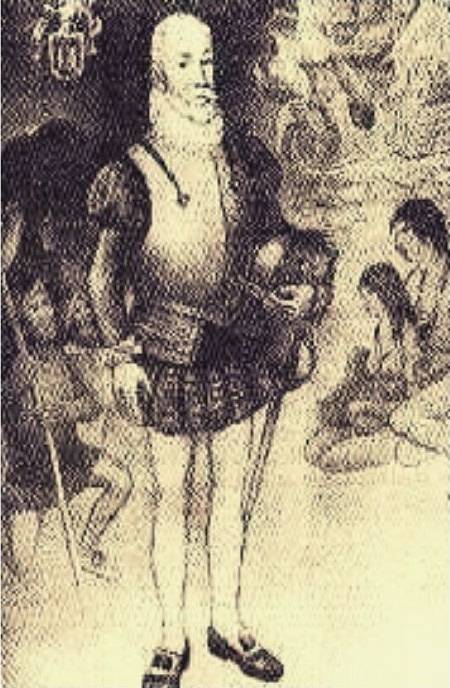
As a navigator, Bastidas accompanied Christopher Columbus on his second voyage to the Indies. This captain was not well known at the time, but in the year 1500 he received authorization from the Spanish Crown to tour the lands that Christopher Columbus had just visited..
Article index
- 1 Biography
- 1.1 Travel to America and exploration
- 1.2 Authorization in 1500
- 1.3 Death
- 2 Trips and routes
- 2.1 Travel with Columbus
- 2.2 First voyage in 1501
- 2.3 Arrival in Santo Domingo
- 2.4 Return to Spain
- 2.5 Possible trip in 1507
- 2.6 New journey in 1524: return to the New World
- 2.7 Treason
- 3 Companions
- 3.1 Vasco Núñez de Balboa
- 3.2 Juan de la Cosa
- 4 Cities founded by Bastidas
- 4.1 Santa Marta
- 4.2 Cartagena de Indias
- 5 References
Biography
The exact date of Bastidas' birth is not known, although it is estimated that it was around the year 1445 in the city of Seville. His profession before embarking on his most prominent journey as a navigator and conqueror, was that of a scribe..
He married Isabel Rodríguez de Romera Tamaris and they had two children; Rodrigo de Bastidas and Rodriguez de Romera and Isabel de Bastidas and Rodríguez de Romera.
Journey to America and exploration
After leaving with Christopher Columbus on his second voyage (1493), de Bastidas asked the Spanish Crown for permission to continue the conquest with his own money. In exchange for allowing him to do so, the Crown demanded a quarter of the benefits he acquired on his travels..
He set out for the New World from Cádiz in 1501 with two ships; the San Antón and the Santa María de Gracia, accompanied by Juan de la Cosa and Vasco Núñez de Balboa.
Authorization in 1500
The authorization given by the Spanish Crown in 1500 was intended to continue the conquest on behalf of the Spanish Crown and visit places that had not been sighted by Christopher Columbus on his previous trips..
Rodrigo de Bastidas left Cádiz in October or September 1501; on that occasion he was associated with two expert navigators: Vasco Núñez de Balboa and the cartographer Juan de la Cosa.
Death
Bastidas' refusal to share the gold he obtained in his travels angered some of his men, including Lieutenant Villafuerte, who led a conspiracy against him that ended the life of the conqueror..
One night in Santa Marta -Colombia-, while Bastidas slept, he was attacked and stabbed. He was able to scream and other men came to his aid. Because they did not have medical supplies, they left for Santo Domingo, although bad weather forced them to divert to Cuba, where they died from injuries..
Later, his son took his remains to Santo Domingo, where he is buried with his wife and son in the Cathedral of Santa María la Menor, in the colonial zone..
Trips and routes
Travel with Columbus
Rodrigo de Bastidas' first great adventure to the American seas was in the company of the conqueror Christopher Columbus on his second expedition.
First voyage in 1501
Later, in the year 1500, the Spanish Crown authorized him to make his own trip..
It was then that he assembled two caravels in the company of the navigators Juan de la Cosa and the adventurer Vasco Núñez de Balboa. In this way he set off on his great American adventure in 1501..
In Bastidas' trip, the same route followed the third voyage of Columbus through Colombian soil and waters. It even reached Venezuelan soil by crossing its coast; stepped on land that had been sighted before by Alonso de Ojeda, Juan de la Cosa and Américo Vespucio.
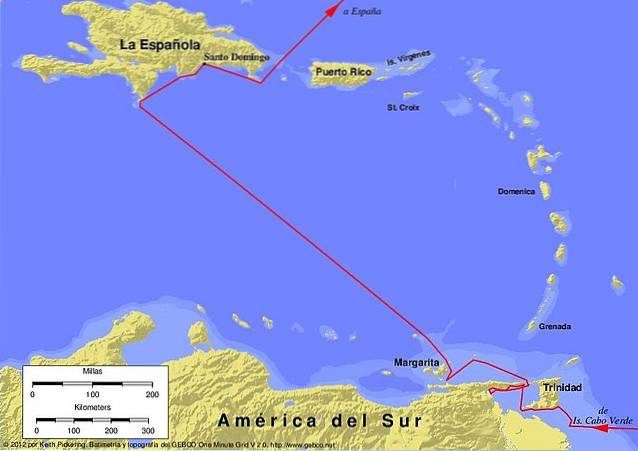
In South America, Bastidas skirted the coasts of Cabo de la Vela, located in Venezuela. Then he left for the west and colonized the Atlantic coast of Colombia. With his travel companions he explored much of this coast, specifically the Santa Marta region.
Later it continued along the coasts of Panama, then passed through the mouths of the Magdalena River, and through the Gulf of Uraba or Darien, now Cartagena de Indias.
Motivated by ship problems for which he was about to be shipwrecked, he decided to divert to Jamaica. There he solved the problem of the boats and continued his journey to Hispaniola.
However, the fate of the navigator was changed thanks to the bad weather that threw him to Cabo de Canonjía, where he again had to repair the ships. This time it took him four weeks to make the repairs..
Then he tried to get back to Santo Domingo on the island of Hispaniola, but was shipwrecked due to bad weather and had to make a stop in Xaraguá, in Haiti..
Arrival in Santo Domingo
In Haiti (also located on the island of Hispaniola) he separated his crew into three groups and undertook a trip by land to Santo Domingo..
After having dedicated himself to trade with the Indians, some authors point out that he was recognized as a man of kind treatment with the Indians.
However, for this work he had to answer in a judgment made by Governor Francisco de Bobadilla. This one caught him and took all the gold from him.
I return to spain
By mid-1502 Captain Rodrigo de Bastidas returned to Spain leaving the Dominican Republic. The trip became dangerous due to bad weather, but he was finally able to reach his destination.
In Spain he was acquitted of all charges. Once de Bastidas paid the Crown all the corresponding rights, he was assigned a life pension. It was derived from the collection of an annual rent on the production of the provinces of Urabá and Zenú.
On December 15, 1521, interested in the Island of Trinidad, he signed a new capitulation to populate it; However, the opposition of Diego de Colón made him desist.
From Santo Domingo he planned another expedition to the Santa Marta region, Bastidas's most enduring work and the one considered the most important in his life..
Possible trip in 1507
According to some sources, in 1507 the colonizer Bastidas and Juan de la Cosa made another trip to Colombian territory; however, there is no reliable information to support it.
New voyage in 1524: return to the New World
The trip of which there is more certainty was the one made in the year 1524, when it was granted around eighty leagues of coast, starting from Cabo de la Vela to the mouths of Magdalena in Colombian spaces..
Rodrigo de Bastidas arrived again in 1525 at the bay of Santa Marta, where he built a fortress that served as the basis for the construction of Santa Marta. Then he continued his conquest in the indigenous territories of Bondigua and Bonda.
In these places he remained next to his rich fortune, product of the looting carried out on the conquered territory. This wealth caused the betrayal of some of his henchmen, who seriously injured him.
Treason
There are versions of different authors that point out that those who stabbed him did so because of his benevolent treatment of the indigenous inhabitants. Those who defend this version indicate that Rodrigo de Bastidas wanted a peaceful coexistence.
However, this turned out to be a symbol of weakness for some of his companions. The latter had traveled the ocean in search of riches and were not willing for the natives to resist them to take away their gold, pearls and other resources..
Whatever the cause of the attack, de Bastidas was betrayed by his companions and mortally wounded. Faced with such events, the explorer decided to travel to Santo Domingo. Motivated by bad weather, his ship never reached that destination, but instead touched the waters of Santiago de Cuba. There he passed away.
Companions
Vasco Nunez de Balboa
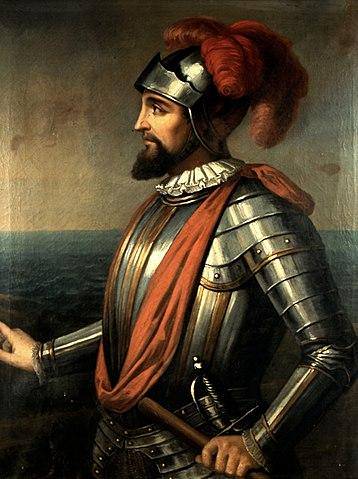
This companion of Rodrigo de Bastidas was of Galician origin. As recorded in history, he was the first European to see the Pacific Ocean from America. When he accompanied de Bastidas, it was also his first trip to the New World..
Juan de la Cosa
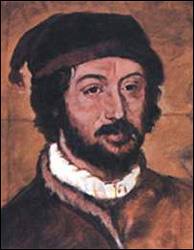
This Spanish cartographer was present on seven of the first trips that were undertaken to America. Its objective was to register the wealth, landscapes and other characteristics of the American lands.
On the first trip he accompanied the navigator Christopher Columbus, not only as an expeditionary, but as the owner of one of the ships that made the crossing.
For the same reason, and given that the boat did not reach the port to a successful end, Juan de la Cosa was tried. However, at the end of the trial, he was declared innocent and, in addition, he was given compensation.
He is credited with the development of the first map of the subcontinent where for the first time the name of America is given.
Cities founded by Bastidas
Santa Marta
History reports that the most important city founded by the Spanish Rodrigo de Bastidas was Santa Marta de Colombia. It happened on July 29, 1525. That day he disembarked in the bay of Gaira.
The name of the new city founded is due to the founder's hometown, since the patron saint of the city of Seville, in Spain, is Santa Marta; It is precisely July 29 that is the day in which honors are paid to the saint.
The foundation was carried out by bringing inhabitants from other regions and some animals, in addition to those present in the area, to guarantee the population's nutrition. The chosen site had a pleasant climate.
Likewise, it was near a river that he christened the La Magdalena river and from which he could begin his journey through the remaining territory. This river also served to supply fresh water to the population.
In Santa Marta he ordered the construction of a fortress that years later would serve as the foundations of the aforementioned Colombian city. He was governor of this city until his death.
Cartagena de Indias
Even though this was not a city founded by Rodrigo de Bastidas, the name of this city is found in most of his biographies..
This is because he was the first European to set foot in this area, which in the future would be founded by the conqueror Pedro Heredia after the combat and murder of its original inhabitants. When de Bastidas arrived, he gave it the name Gulf of Barú.
References
- Biographies and Lives. (2004-2018) Rodrigo de Bastidas. The Online Biographical Encyclopedia. Recovered in: biografiasyvidas.com
- Illustrated Universal Encyclopedia, Editorial Cantábrica, volume 3, Viszcaya Spain.
- Enciclopedia Universal Ilustrada (1973), European-American, Espasa-Calpe, S.A., Madrid, Spain, Volume VII, pp 1108.
- Gran Enciclopedia Rialp GER, (1971) Ediciones RIALP, S.A., Volume III.
- Nauta, (2005). Encyclopedia of Great Characters, Barcelona, Spain.

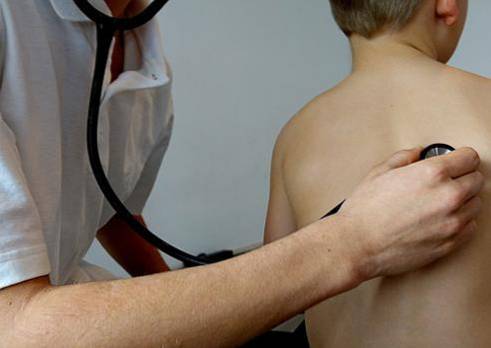
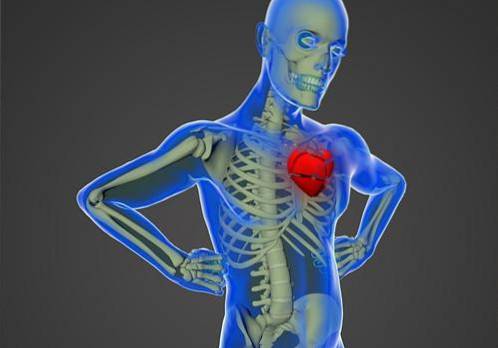
Yet No Comments